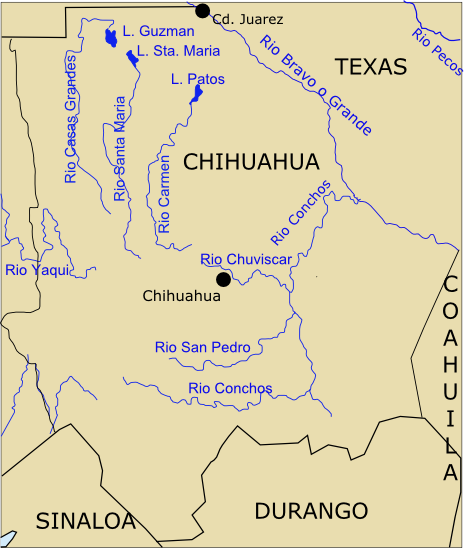Guzmán Basin on:
[Wikipedia]
[Google]
[Amazon]
 The Guzmán Basin is an
The Guzmán Basin is an
 The Guzmán Basin is an
The Guzmán Basin is an endorheic basin
An endorheic basin ( ; also endoreic basin and endorreic basin) is a drainage basin that normally retains water and allows no outflow to other external bodies of water (e.g. rivers and oceans); instead, the water drainage flows into permanent ...
of northern Mexico
Mexico, officially the United Mexican States, is a country in North America. It is the northernmost country in Latin America, and borders the United States to the north, and Guatemala and Belize to the southeast; while having maritime boundar ...
and the southwestern United States
The United States of America (USA), also known as the United States (U.S.) or America, is a country primarily located in North America. It is a federal republic of 50 U.S. state, states and a federal capital district, Washington, D.C. The 48 ...
. It occupies the northwestern portion of Chihuahua in Mexico, and extends into southwestern New Mexico
New Mexico is a state in the Southwestern United States, Southwestern region of the United States. It is one of the Mountain States of the southern Rocky Mountains, sharing the Four Corners region with Utah, Colorado, and Arizona. It also ...
in the United States.
Notable rivers of the Guzmán Basin are the Casas Grandes River, which empties into Lake Guzmán, the Santa Maria River, which empties into Lake Santa Maria, the Carmen River, and the Mimbres River of New Mexico.
The Guzmán Basin is home to several endemic
Endemism is the state of a species being found only in a single defined geographic location, such as an island, state, nation, country or other defined zone; organisms that are indigenous to a place are not endemic to it if they are also foun ...
and near-endemic fish species, including the Chihuahua chub ''(Gila nigrescens)'', Palomas pupfish ''(Cyprinodon pisteri)'', Whitefin pupfish ''(C. albivelis)'', Perrito de carbonera ''(C. fontinalis)'', and Guzmán trout ''(Oncorhynchus mykiss nelsoni)''.
References
* Ricketts, Taylor H; Eric Dinerstein; David M. Olson; Colby J. Loucks; et al. (1999). ''Terrestrial Ecoregions of North America: a Conservation Assessment.'' Island Press;Washington, DC
Washington, D.C., formally the District of Columbia and commonly known as Washington or D.C., is the capital city and Federal district of the United States, federal district of the United States. The city is on the Potomac River, across from ...
.
* Echelle, Anthony A. (2004) "Death Valley Pupfishes, mtDNA Divergence Times and Drainage History" in Reheis, Marith C. (ed.) ''Geologic and Biotic Perspectives on Late Cenozoic Drainage History of the Southwestern Great Basin and Lower Colorado River Region: Conference Abstracts''. Open-File Report 2005–1404, US Geologic Survey.
*Minckley WL, Miller RR, Norris SM (2002). "Three New Pupfish Species, Cyprinodon (Teleostei, Cyprinodontidae), from Chihuahua, México, and Arizona, USA". ''Copeia'': Vol. 2002, No. 3 pp. 687–7.
*Propst, David L. and Jerome A. Stefferud (1994) "Distribution and Status of the Chihuahua Chub (Teleostei: Cyprinidae: Gila nigrescens), with Notes on Its Ecology and Associated Species". ''The Southwestern Naturalist'', Vol. 39, No. 3 (Sep., 1994), pp. 224–234.
* Robert J. Behnke, Trout and Salmon of North America. publisher The Free Press, . Year 2002. pages=115–122, chapter Rainbow trout of Mexico.
Drainage basins of Mexico
Endorheic basins of North America
Endorheic basins of the United States
Landforms of Chihuahua (state)
Landforms of New Mexico
Freshwater ecoregions
Ecoregions of Mexico
{{NewMexico-geo-stub